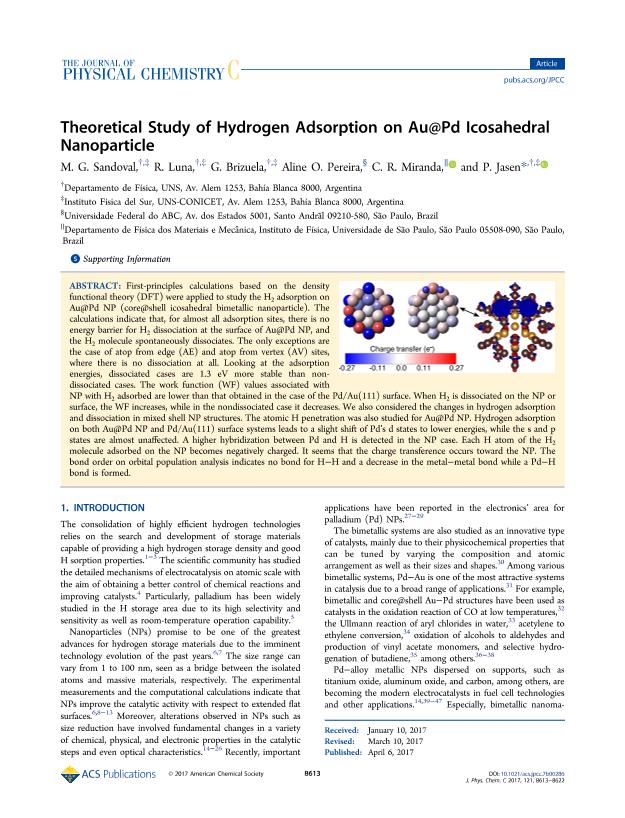Artículo
Theoretical Study of Hydrogen Adsorption on Au@Pd Icosahedral Nanoparticle
Sandoval, Mario German ; Luna, Roman Jorge; Brizuela, Graciela Petra
; Luna, Roman Jorge; Brizuela, Graciela Petra ; Pereira, Aline O.; Miranda, C. R.; Jasen, Paula Verónica
; Pereira, Aline O.; Miranda, C. R.; Jasen, Paula Verónica
 ; Luna, Roman Jorge; Brizuela, Graciela Petra
; Luna, Roman Jorge; Brizuela, Graciela Petra ; Pereira, Aline O.; Miranda, C. R.; Jasen, Paula Verónica
; Pereira, Aline O.; Miranda, C. R.; Jasen, Paula Verónica
Fecha de publicación:
06/04/2017
Editorial:
American Chemical Society
Revista:
Journal of Physical Chemistry C
ISSN:
1932-7447
Idioma:
Inglés
Tipo de recurso:
Artículo publicado
Clasificación temática:
Resumen
First-principles calculations based on the density functional theory (DFT) were applied to study the H2 adsorption on Au@Pd NP (core@shell icosahedral bimetallic nanoparticle). The calculations indicate that, for almost all adsorption sites, there is no energy barrier for H2 dissociation at the surface of Au@Pd NP, and the H2 molecule spontaneously dissociates. The only exceptions are the case of atop from edge (AE) and atop from vertex (AV) sites, where there is no dissociation at all. Looking at the adsorption energies, dissociated cases are 1.3 eV more stable than nondissociated cases. The work function (WF) values associated with NP with H2 adsorbed are lower than that obtained in the case of the Pd/Au(111) surface. When H2 is dissociated on the NP or surface, the WF increases, while in the nondissociated case it decreases. We also considered the changes in hydrogen adsorption and dissociation in mixed shell NP structures. The atomic H penetration was also studied for Au@Pd NP. Hydrogen adsorption on both Au@Pd NP and Pd/Au(111) surface systems leads to a slight shift of Pd's d states to lower energies, while the s and p states are almost unaffected. A higher hybridization between Pd and H is detected in the NP case. Each H atom of the H2 molecule adsorbed on the NP becomes negatively charged. It seems that the charge transference occurs toward the NP. The bond order on orbital population analysis indicates no bond for H-H and a decrease in the metal-metal bond while a Pd-H bond is formed. (Figure Presented).
Palabras clave:
Hydrogen
,
Au@Pd Nanoparticles
,
Catalysis
,
Dft
Archivos asociados
Licencia
Identificadores
Colecciones
Articulos(IFISUR)
Articulos de INSTITUTO DE FISICA DEL SUR
Articulos de INSTITUTO DE FISICA DEL SUR
Citación
Sandoval, Mario German; Luna, Roman Jorge; Brizuela, Graciela Petra; Pereira, Aline O.; Miranda, C. R.; et al.; Theoretical Study of Hydrogen Adsorption on Au@Pd Icosahedral Nanoparticle; American Chemical Society; Journal of Physical Chemistry C; 121; 15; 6-4-2017; 8613-8622
Compartir
Altmétricas



